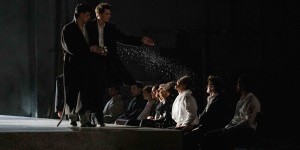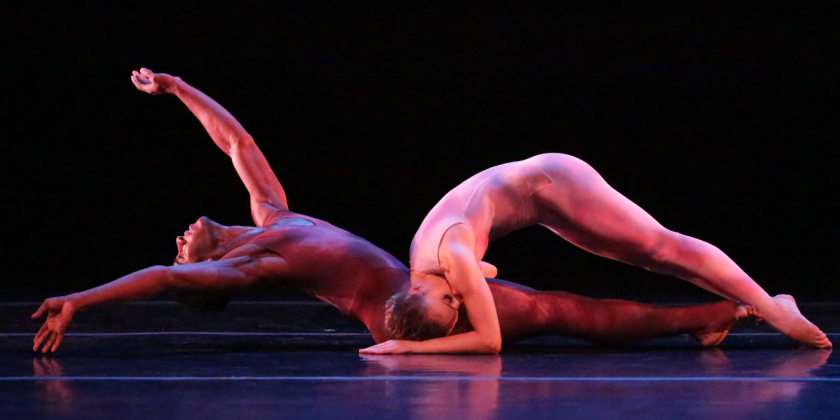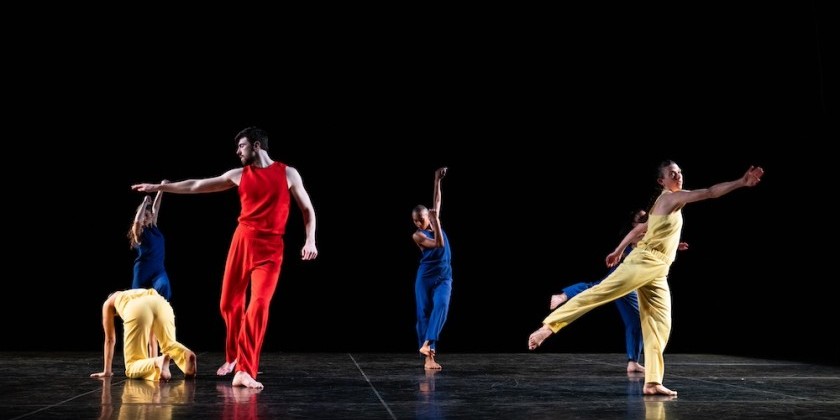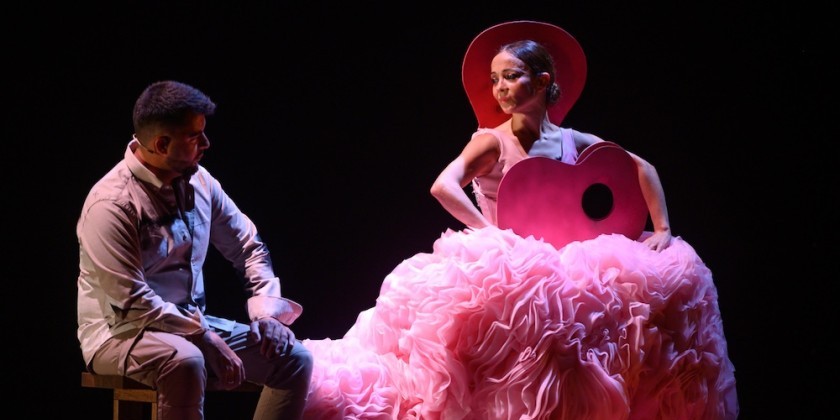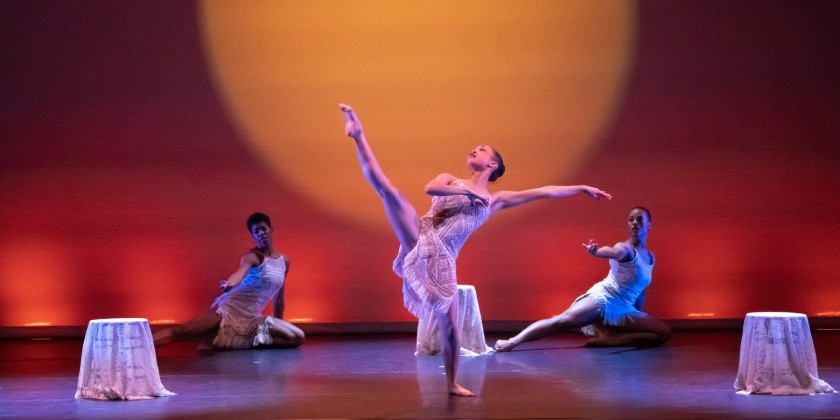IMPRESSIONS OF: "Tree of Codes" at the Park Avenue Armory
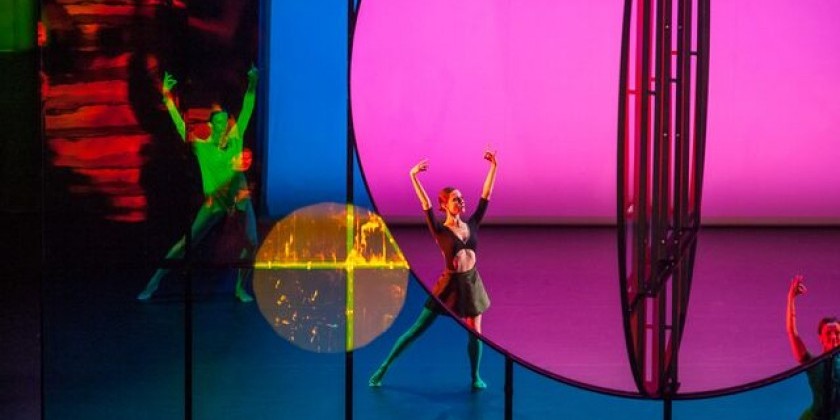
Director and Choreographer: Wayne McGregor/Visual Concept: Olafur Eliasson/Composer: Jamie xx
Inspired by “Tree of Codes” by: Jonathan Safran Foer
Sound Designer: Nick Sagar/Lighting Realization: Rob Halliday/Rehearsal Director: Odette Hughes
Performed by soloists and dancers from Paris Opera Ballet and Company Wayne McGregor
U.S. Premiere presented by the Park Avenue Armory, September 14-21, in New York City
A book that “remembers it has a body,” seems more human than one that doesn’t, novelist Jonathan Safran Foer told an interviewer in Vanity Fair. He was speaking about his “Tree of Codes,” a book with a sculpted interior, which is also an audacious act of decryption as Foer took a razor-blade to another writer’s short stories to carve out a new narrative. You can see how this statement about books and bodies might tempt a brainy choreographer, and how the prospect of secret messages---even a whole novel---hidden within a volume of innocent-looking prose might appeal especially to Wayne McGregor.
McGregor, the British dance maker whose ballet Tree of Codes arrived at the Park Avenue Armory on Monday after making its debut this summer at the Manchester International Festival, loves ingenious and recondite ways of making things. Scientists who crack codes and solve mysteries also fascinate him. Yet McGregor’s own works frequently move in the other direction, reverse-engineering the world and waxing enigmatic. Think of Entity, where his performers wore their DNA signatures on their shirts, or Atomos, where the choreographer used the dancers’ biometric data to generate movement. Don’t forget to bring your Captain Midnight decoder ring to these performances, kids.
A dance doesn’t have to remember that it has a body. In dance, the body is usually a given. Unlike a book, a dance must remember that it has a soul. Yet in the mirror-world of Tree of Codes, it’s far from clear where a soul might reside.
The body is the centerpiece of dance, but de-materializing it seems to be the first order of business here, courtesy of visual artist Olafur Eliasson who, along with composer Jamie xx, collaborated with McGregor on this flamboyant production. As viewers enter the Armory’s Wade Thompson Drill Hall skirting an enormous stage erected in the center, they cast bright, candy-colored shadows on screens hanging against the wall. Passersby are implicated from the outset, playfully recruited for an adventure and connected to the artists at the speed of light (outstripping even super-fast broadband cable). Yet, like much of the imagery in Tree of Codes, our shadows hide more than they reveal.
When the dancers first appear, they, too, have an insubstantial presence. They move in pitch blackness, with points of light attached to their arms and legs sketching their positions. They stride. They leap. They recline. The little beacons glom together and spread apart. A lift makes an electric diagram; and when the dancers bounce they’re jiving constellations.
Then silvery reflectors appear, aimed at us like megaphones. Instead of amplifying a voice, however, they magnify an image. Each reflector has a person’s arm inside, and the faceted interior multiplies the twisting hand at its center.
So far, all this imagery is merely decorative. Will Tree of Codes reach higher? Two dancers enter, their bodies visible now in flesh-colored skivvies. Travis Clausen-Knight pursues Catarina Carvalho, adjusting her head when she looks away. When she drops out of his grasp and tries to escape, he seizes her extended leg. Their movement conversation is urgent, filled with squiggly gestures and abrupt lifts. Soon other figures appear on stage, not only because more dancers join in, but also because the backdrop begins to mirror people. Under the stage lights, the reflections are so clear that they look real.
This mirroring will prove the dominant feature of Tree of Codes, perhaps suggesting the relationship between Foer’s book and its source, or the ghostly lingering of dead authors with haircuts. Eliasson, who is credited with this “visual concept,” isn’t trying to trick us. Some of the reflections are tinted and patently false. He wants us to know which dancers are real and which illusory, if only so we can admire the skill with which he creates environments that the living dancers and reflections appear to share.
Raising and lowering stage-length screens, cracking them open in the manner of cut-outs, and making them transparent, reflective or opaque, Eliasson and lighting technician Rob Halliday call the shots. The choreographer is at a disadvantage here, stripped of his customary ability to define the space by positioning bodies within it. Like Foer, he should be able to carve out a text, and a home, for himself. McGregor often works with designers, of course, but Eliasson’s setting is far more intrusive in the way it divides the stage than, say, John Pawson’s architecture for Chroma. It comes closer to the visual sleight-of-hand in AtaXia, a dance that aspires to the condition of a video with its Perspex panels and graphics.
The dance called Tree of Codes is consequently less like a novel, even a provocatively sculptural one, and more like the disembodied realms of the Internet or a video game. In those virtual spaces nobody knows if you are real (are you, still?); as people with shell identities or avatars submerge themselves in digital fantasies. Those fantasies are limited, of course, in ways that novels, cinema, more conventional forms of theater and real life are not. The superficiality common to video games, texting and anonymous, online chat reflects the shallowness of our age. Why are these toys so attractive?
Like the Internet, again, Tree of Codes swallows everything. The colorful shadows that we generate upon entering the Drill Hall are merely a prelude to the moments when Eliasson’s scenery mirrors us, too, with a spotlight passing over the audience and picking out small groups seated in the bleachers. Transposed to the stage we participate in the spectacle effortlessly floating alongside the dancers, our figures dyed red or crisply detailed in white light as we watch ourselves watching and everyone has a few seconds of fame.
Speed is a McGregor trademark, and a condition of modern life, but the dancers in Tree of Codes seem a mite too desperate, nervously twiddling their fingers and rushing to grab Daniela Neugebauer so they can hoist her into the air as a group of them races to beat the clock. Do they feel death or madness approaching? It’s hard to say. In an unusually quiet moment that seems telling, two men sit and regard each other, smugly noticing the way their poses mirror each other. Simply mirroring---neither asking nor answering intimate questions---appears sufficient.
Even when they grapple feverishly McGregor’s dancers seem connected in a way that does not promote meaningful exchanges. The choreography is imaginative and bodies skillfully articulated, but he doesn’t establish characters or tell us about the performers, who seem pressed and eager to complete their tasks without elaborating. Within a spectacle that is eminently self-aware, his choreography hangs back modestly refusing to point out a clever invention or a situation by framing it. Eliasson does all the framing. The dancing manages to be succinct without revealing anything, which makes it feel repetitive. The texture or rhythm of the music, now clacking rhythmically and then singing a song, seems to have a negligible effect on McGregor’s decisions; and the music washes over the dancers rather than channeling the action.
Should the choreography do more than simply exist? Perhaps it would, if it didn’t have to accommodate its projected doubles in a space that only partly belongs to it. Instead we must rely upon the performers to create excitement; and they do. The cast, which combines dancers from McGregor’s own company with others from the Paris Opera Ballet, includes some stunners.
Though his flexibility lends itself to contortions, Alvaro Dule’s chief talent is his ability to move fluently; and it’s ravishing to watch him when he is all of a piece and focused on arriving somewhere. James Pett, another McGregor stalwart, has a cunning, sharp attack. Neugebauer’s energy seems unquenchable; while expressive Fukiko Takase asserts herself achieving a wry, personal detachment even amid intense negotiations. Another dancer with a “voice” is scrappy, powerful Jérémie Bélingard---the one you want on your team---whose great moment ironically is not a feat of strength but arrives with the final, poignant gestures of a solo. In Tree of Codes it feels terrible to be alone, even when one’s companions are so busy. And there is Marie-Agnès Gillot, whose spectacular line and arched feet earn a well-deserved kiss from her duet partner, Julien Meyzindi, though sadly the line and the kiss are both wasted in this context.
Who will pull this fragmented world together? Not McGregor, and certainly not Eliasson, who becomes absorbed in coloring his design and by the end of Tree of Codes is blowing bubbles---giant polka-dots of tinted light that float across the increasingly gaudy scene.
The notion that dances might have souls, is, of course, a slippery one and anyone who mentions it may be suspected of humbug. Yet if by “soul” we mean the essential thing that gives meaning and identity to a work of art by linking it to the experience of human life---then dances certainly do have souls. Tree of Codes reflects this humanity but dimly.
McGregor should either make the leap to cinema, where he would be less constrained, or he should bring his dancers back into the real world.
Share Your Audience Review. Your Words Are Valuable to Dance.
Are you going to see this show, or have you seen it? Share "your" review here on The Dance Enthusiast. Your words are valuable. They help artists, educate audiences, and support the dance field in general. There is no need to be a professional critic. Just click through to our Audience Review Section and you will have the option to write free-form, or answer our helpful Enthusiast Review Questionnaire, or if you feel creative, even write a haiku review. So join the conversation.






